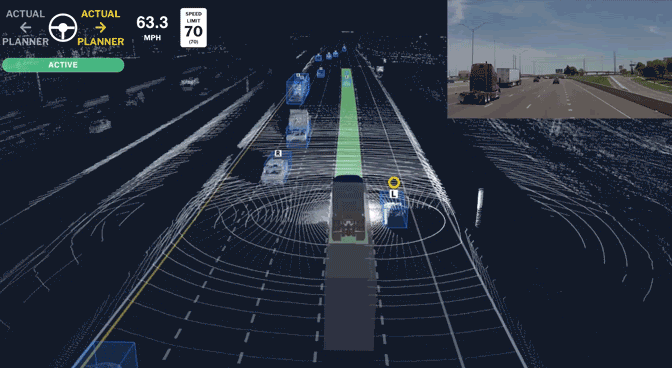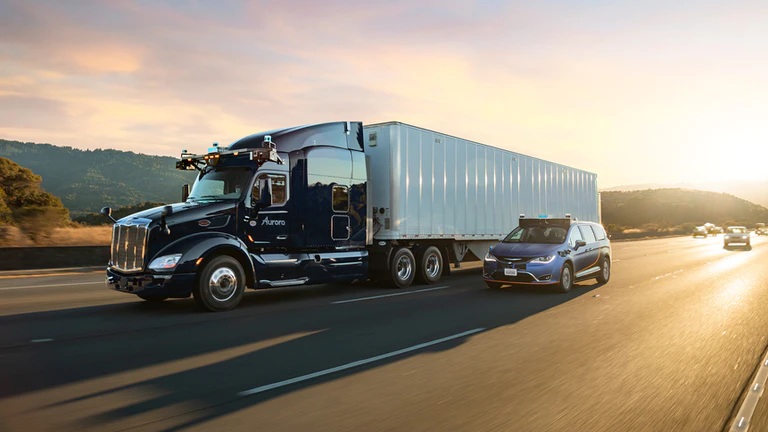With a friendly regulatory—and weather—environment, autonomous trucking and technology firms are finding plenty of space to play in the Lone Star State.
If you’ve traveled on a major highway in Texas recently, there’s a good chance you’ve shared the road with a self-driving tractor-trailer. Artificial intelligence is putting the virtual pedal to the metal in long-haul trucking this year. Nowhere else in the U.S. is that more evident than in the Lone Star State.
More and more trucking technology companies are moving from conceptual to actual self-driving tractors as the industry gets closer to taking the human out of the cab to move freight in the U.S. by the middle of the decade.
Another player in the advanced truck technology space, Aurora, said it is working 24/7 to make it possible to transport freight by truck from Dallas to Los Angeles in less than 24 hours.
As the company notes in a May 27 blog post, it can take nearly three days for a truck driver to haul goods from Texas to California. But artificial intelligence doesn’t need to be bound by the same hours-of-service regulations that limit human commercial drivers. “When it’s deployed on this route, we expect the Aurora Driver to make the 1500-mile trip in less than 24 hours,” the company said of its AI-powered technology.
Aurora, founded in 2017 by autonomous technology developers Chris Urmson, Drew Bagnell, and Sterling Anderson, has been spending the past few years laying the foundation for its self-driving trucks. The company, which has financial backings from Amazon and Sequoia, has partnered with Volvo Trucks, Paccar, Uber, FCA, and Hyundai Group to test its AI technology in Texas, California, and Pennsylvania.
Texas Triangle
 Image: Wikimedia CommonsLike its rivals TuSimple, Waymo, and Kodiak Robotics, Aurora has been focusing much of its Level 4 autonomous truck testing within the Texas Triangle, which includes the state’s five largest cities. While all of these companies still operate with safety drivers in the cabs of these self-driving trucks, they each claim to be getting closer to safely removing humans from the equation.
Image: Wikimedia CommonsLike its rivals TuSimple, Waymo, and Kodiak Robotics, Aurora has been focusing much of its Level 4 autonomous truck testing within the Texas Triangle, which includes the state’s five largest cities. While all of these companies still operate with safety drivers in the cabs of these self-driving trucks, they each claim to be getting closer to safely removing humans from the equation.
Dallas and Houston are two of the biggest freight hubs in the U.S. “Operating in that environment, we can test our Waymo Driver on highly dense highways and shipping lanes, further understand how other truck and passenger car drivers behave on these routes—and continue to refine the way our Waymo Driver reacts and responds in these busy driving regions,” a Waymo spokesperson told FleetOwner late last year when the Google-related company announced its plans to start testing self-driving Peterbilts in Texas.
Since the last decade, the Texas Department of Transportation has been working to lure in transportation technology companies to test their products across the state. “In Texas, at least today, the regulatory environment is is very favorable and very positive,” Don Burnette, Kodiak’s CEO and co-founder, told FleetOwner recently. “We have a very close relationship with multiple levels of government officials in Texas and at the federal level as well.”
This week, Kodiak announced a partnership with a South Korean conglomerate to bring its self-driving technology to the vast Asian freight market and has been hauling freight in self-driving trucks between Dallas and Houston since 2019. “We deliver freight every day for customers—real paying customers,” Daniel Goff, head of policy for Kodiak, told FleetOwner this spring. “That’s really exciting. People don’t necessarily realize that their latest iPhone might have been delivered by an autonomous truck.”
With its traditionally warm and dry climate and friendly regulations, Texas has been a big draw for Silicon Valley’s nascent technology. Big block letters on the Kodiak website read: “Born in CA. Raised in TX. Moving goods since 2019.”
While many self-driving companies have expanded their testing programs to more temperate climates in the East and Midwest, Texas and its neighboring states are still the most popular locations for the autonomous freight movement pilot programs. Kodiak’s Burnette said his company will continue to expand its Texas operations. “We think there are many other states that are also very favorable with what we’re working on—but we definitely will be in Texas ensuring that we have the freedom to operate over the next several years,” he said.
TuSimple, which plans to run nearly coast-to-coast autonomous tests by the end of the year, is still primarily in the Southwest. “We’re targeting the South—right now it’s predominantly Texas, Arizona, and New Mexico,” Jim Mullen, TuSimple’s CAO, told FleetOwner recently. “We’re going to be expanding by the end of the year into Florida, Georgia, North Carolina… as we work with our strategic partners on where they want us to be.”
TuSimple, like most of the AV trucking players, is based or at least started in California. But when it comes to regulations, the two states are a lot further apart than even that three days’ drive from Dallas to Los Angeles. “As you know, California has some regulatory barriers that we haven’t overcome yet,” Mullen said. “But we’re working on it.”
So “the Texas Triangle is going to be a big area for us,” he said, as TuSimple expands the autonomous runs it is currently making with 50 self-driving trucks running freight with humans on board as a backup.
The biggest state in the Lower 48 appears to have plenty of room for the trucks of the future. In its recent blog post, Aurora noted that the company has already outgrown its first Dallas office and will soon move into a more prominent location “to accommodate our expanding team and testing fleet. Over the next year, we’ll continue to mobilize and recruit passionate autonomous operations specialists, service engineers, hardware and software engineers to join us in making trucking safer and more efficient than ever before.”
As the company works to refine the Aurora Driver system, it is expanding its deployment with shippers and carriers. “Over the next year, expect to see more autonomous trucks with the Aurora Driver on Texas roads as we engage with key logistics companies in commercial pilots,” the company announced.
Aurora plans its initial pilot routes to originate within the Texas Triangle and focus on freight middle miles. “The Aurora Driver will operate autonomously with a safety driver between transfer hubs, or ‘terminals,’ to enable us to efficiently consolidate loads from multiple sources,” the company’s announcement read. “For shippers and carriers with existing hubs and large volumes of freight, we expect to ultimately drive the complete route with no need for an intermediate consolidation point.”
Aurora refined its mapping program, Aurora Atlas, to develop high-definition maps for these middle miles across Texas. “Our strong mapping foundation in Texas helps us rapidly and seamlessly add routes as we improve our technology and expand services throughout the Southwest corridor,” it said.

The Aurora Driver system detects other vehicles around it as it moves along a divided highway, as depicted in this graphic.Image: Aurora
By Josh Fisher
Source: https://www.fleetowner.com/
CUT COTS OF THE FLEET WITH OUR AUDIT PROGRAM
The audit is a key tool to know the overall status and provide the analysis, the assessment, the advice, the suggestions and the actions to take in order to cut costs and increase the efficiency and efficacy of the fleet. We propose the following fleet management audit.




